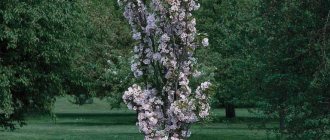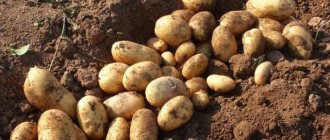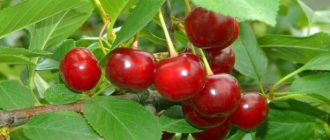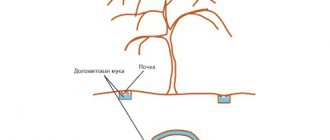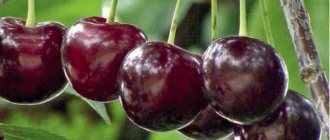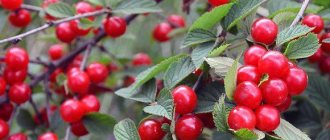Description of the variety
Cherry Molodezhnaya is a bush cherry variety bred from crossing the Lyubskaya and Vladimirskaya varieties. This cherry grows up to 2.5 meters in height. Features of the variety:
- The variety is self-fertile, frost-resistant;
- the crown of the tree is round, drooping;
- The yield is good, with an average fruit ripening period (July). Fruiting is annual. One bush gives a harvest of up to 15 kg;
- The fruits are large (4.5 g), with juicy and dense pulp. The color of the berries is dark red, the taste is sweet and sour. The bone is well separated from the pulp. The smell is rich cherry;
- bears fruit on last year's growths and bouquet branches.
Table: advantages and disadvantages of the variety
| Advantages | Flaws |
| Small tree crown | Rapid overgrowth (requires frequent thinning of branches) |
| Self-fertility | Average resistance to fungal diseases |
| Resistance to fruit shedding | |
| Juiciness of berries | |
| Good transportability of berries | |
| Free separation of pulp from stone | |
| Excellent taste of fruits | |
| Precocity |
Photo gallery: Molodezhnaya cherry
Cherry blossom Youth
Molodezhnaya cherry berries are colored in different shades of red depending on the degree of ripeness.
Fruit-bearing cherry bush Molodezhnaya
Video: description of Molodezhnaya cherry
Origin and zoning
The variety was bred on the basis of the All-Russian Selection and Technological Institute of Horticulture and Nursery Growing (VSTISP) in the late seventies of the last century. Its authors are Doctor of Biological Sciences, specialist in the study of stone fruits Khasan Karimovich Enikeev and agronomist-pomologist Sanya Nasatdinovna Satarova.
“Molodezhnaya” was obtained as a result of crossing two ancient varieties of folk selection: “Lyubskaya” and “Vladimirskaya”. Both of them have long been cultivated in the Central and more northern regions of Russia, zoned in the regions of the Black Earth Region, the North Caucasus, the Middle and Lower Volga region; since 1947 included in the State Register.
The parent forms were proven “donors” – “Vladimirskaya” (pictured on the left) and “Lyubskaya” (right)
In 1993, the Molodezhnaya cherry variety was included in the State Register of the Russian Federation, recommended for cultivation in the Moscow region (Central region).
During field tests in 2016 in experimental plantings near Michurinsk (Tambov region), “Molodezhnaya” proved to be quite winter-hardy: when the freezing temperature dropped to −38 ℃, reversible freezing was observed, not higher than 2 points (on a 6-point scale), damage to wood and vegetative buds. Increased resistance to coccomycosis and clasterosporiasis was noted (degree of damage up to 2.0 points); average – to moniliosis (2.5 points).
Landing
The best place to plant cherries is a well-lit area, protected from cold winds. Places near fences and buildings are suitable. Young trees need to be planted in the spring, before the buds begin to awaken.
The distance between planted trees should be 2 meters in a row and 3 meters between rows. Despite the self-fertility of the Molodezhnaya variety, breeders still advise planting at least one more cherry of a different variety nearby (for cross-pollination).
During flowering, you can spray cherry flowers with a weak solution of honey with the addition of boric acid. Honey will attract pollinating insects, and boron will give strength to flowers for more ovaries and protect them from falling. In addition, boron is an excellent antiseptic and insecticide. Boric acid consumption: 10 grams per 10 liters of water. Boron is diluted only in warm water!
How to choose quality seedlings
- When choosing planting material, pay special attention to the roots of the seedlings. They must have at least 3 branches with many lateral processes. Healthy roots are elastic and unbreakable.
- Also inspect the bark, ideally it does not have blackened areas and does not peel off. The branches are located on all sides, not just one, and also have branches.
- Choose seedlings in nurseries, and not at bazaars, where they can “hand you” another variety instead of one. It is better to take 2-year-old seedlings that take root well. Cherries begin to bear fruit at 3–4 years. It happens that already in the second year the cherry tree begins to bloom (depending on the region of planting).
- When transporting seedlings to the planting site, the roots must be protected from drying out.
Saplings with greenish bark and a height of more than 1.5 meters are not suitable for planting.
Healthy and high-quality planting material is the key to a good harvest
Step-by-step instructions for planting cherries with an open root system
You should prepare in advance:
- fertilizer. For each hole: 15–30 kg of organic matter, 200 g of phosphorus, 60 g of potassium or 0.5 kg of ash;
- the drug Kornevin for good root survival;
- complex solution against diseases and pests for treating branches and bark;
- if you plan to do drainage - crushed limestone;
- a wooden stake for each seedling and twine for tying.
Planting process
- Dig a planting hole with a diameter of 80 cm and a depth of 60 cm. Place the top layer of soil in one direction and the bottom layer in the other (the top fertile layer will need to be poured down onto the roots of the seedling). Place crushed limestone at the bottom of the hole. It will regulate the acidity level in the soil and provide good drainage.
- Mix the top layer of soil from the hole with the prepared fertilizers. A little further from the center of the hole, install a stake to support the seedling and pour a small mound of prepared soil.
- Place the seedling in the middle next to the stake, add Kornevin, and cover the roots with soil. The root collar of the seedling should be 5 cm above the soil level to account for subsidence. Add the rest of the soil around the seedling and compact it carefully.
- Tie the seedling to the peg with a twist so as not to overtighten the trunk.
- You need to make a small watering hole around the crown of the seedling and pour a roll of soil along its outer edges to prevent the water from spreading. Depending on the soil moisture, 1–3 buckets of water are poured into the hole. Sprinkle the hole with soil or humus to prevent the soil from drying out.
- Spray the trunk and branches of the seedling with a solution against diseases and pests.
The diameter and depth of the planting hole is 80 cm
Video: planting stone fruits with a closed root system
Advantages and disadvantages
Molodezhnaya is one of the most reliable cherry varieties in terms of yield and has many advantages:
- early ripening (fruits in 3–4 years);
- large-fruited;
- dessert taste of berries;
- good transportability;
- self-fertility;
- high frost resistance;
- drought resistance, which allows the tree to be grown in dry areas;
- abundant fruiting.
No significant deficiencies were identified in Molodezhnaya; only average resistance to fungal diseases was noted.
Molodezhnaya is one of the most reliable varieties; it bears fruit well under any conditions.
Cherry care Youth
To successfully grow cherries, you need to care for them, starting from planting and throughout their life.
On average, a cherry tree remains fruitful for up to 15 years. This period can be extended by following certain agricultural techniques to more than 20 years of fruiting.
But if the owner does not devote enough time to his tree and does not take measures to eliminate diseases and pests, then one cannot count on a good harvest even from a young tree! Cherry branches begin to become bare, the fruits become small and, despite good flowering, few ovaries are formed. Due to poor agricultural technology, there is a weak growth of branches, as a result, the yield decreases both in the current year and in subsequent ones.
Good cherry tree care includes:
- Fertilizer.
- Loosening tree trunk circles.
- Pest treatment.
- Spring-autumn whitewashing of cherry tree trunks.
- Pruning branches.
- Timely watering.
The trunk circles under the cherry tree should always be clean of turf and weeds; only planting green manure (plants that are then used as fertilizers - legumes, mustard, clover, etc.) is possible. There should be no crust on the surface of the soil, so after rain and watering it is necessary loosen the top layer a little (not too much, so as not to damage the roots).
Productivity of the Molodezhnaya cherry variety
The first harvest from trees of this variety can be harvested 4-5 years after planting the seedlings in a permanent place.
With good care, Molodezhnaya cherries consistently bear fruit for at least 15-17 years. Regular pruning of shoots has a positive effect on the yield level.
From the age of 6-7, you can collect up to 10-15 kg of ripe, tasty berries from each Molodezhnaya cherry tree.
The berries ripen by the end of July. The fruits cannot ripen once they are picked from the tree, so the berries must be picked when fully ripe. But you should remember that even overripe fruits are firmly attached to the stalks and do not fall off, so it is important not to miss the moment of their ripening. After all, the taste of overripe cherries deteriorates.
Cherry feeding
To improve the composition of the soil, it must be fertilized. It is recommended to prepare the soil for planting in the fall.
Many gardeners buy young trees and simply plant them in hastily dug holes. But if you want good harvests from your cherries, then the planting holes need to be prepared in advance!
Acidic peat soils with close groundwater are not suitable for cherries. For deoxidation, an average of 300–400 g of dolomite flour or slaked lime is used for autumn digging. For cherries, the soil acidity indicator should be neutral or close to it (pH 6.5–7.0). When planting, crushed limestone drainage is a good way to regulate acidity.
A good way to neutralize acidity is ash. In addition, it is an excellent fertilizer.
The first year after planting, the seedling does not need to be fertilized. The supply of nutrients that are added to the planting hole will be enough for him.
In the first four years, it is necessary to feed the cherries with nitrogen several times a season until July. For cherries over 7 years old, the dose of fertilizer is increased by 30%.
During the period of growth and fruit set, you can feed the cherry with nitrogen through spraying: dilute 50 g of urea in a bucket of warm water and spray the bush.
Table: cherry feeding scheme
| Month | Types of fertilizing |
| April | Nitrogen |
| May | Mineral |
| June | Organic, nitrogen |
| July | Mineral |
| September | Phosphorus-potassium (agrophosphate), organic |
Video: how to determine soil acidity
Table: how to determine what a cherry is missing
| Microelement | Signs of deficiency | The best way to feed |
| Nitrogen | The shoots grow weakly and develop slowly, the leaves turn pale and quickly age. | calcium nitrate (30 g per 1m2) |
| Potassium | A reddish border or spotting appears along the edges of the leaves. | potassium sulfate (20 g per 1m2) |
| Phosphorus | There is a purple tint on the leaves. | superphosphate (60 g per 1m2) |
Nitrogen fertilization
It is necessary to feed the cherries with nitrogen several times in the spring and at the very beginning of summer, when the cherries are growing. When planting, it is better not to add nitrogen, so as not to worsen the survival rate of the seedling .
It is better to apply nitrogen fertilizers for cherries in the form of calcium or sodium nitrate. Other types of nitrogen should be used together with lime, as they have soil acidifying properties.
Subtleties of care and cultivation features
Cherries must be protected from hares and voles, which can cause significant damage to the root system. There is no need to poison animals or set traps; you can simply fence the plant with a thick stake or cover the hole so that you cannot get to the roots.
Feeding
In spring, it is best to feed cherries with mineral fertilizers. For this, there are such proven preparations as Izumrud, Biem for fruits or any other specialized one in the complex. It must be remembered that in the spring during the growing season, fruit trees devote a significant part of their energy to flowering, foliage and shoot growth. Potassium, nitrogen and phosphorus are extremely important in April - May. Be careful with ammonium nitrate, as too much can burn the root system.
It is important to apply the mineral complex before fruit set during the flowering period
The second time you need to feed the cherry after fruiting. Superphosphate and potassium chloride (4 tablespoons each) are diluted with warm water (15 liters) and poured into the tree trunk circle. Such fertilizing in the autumn will allow the tree to recover after it has devoted all its energy to ripening the berries.
In the fall, it’s a good idea to water the cherries once or twice with an infusion of chicken manure or mullein (organic matter with water in a ratio of 1:10).
You cannot add fresh manure, only rotted manure or liquid infusion.
Trimming
After the cherry tree has “woke up” from the winter cold, pruning can be done. It is optimal to remove all shoots from last year; ideally, about 12–14 shoots should remain on the bush. Where you cut it, be sure to cover it with garden varnish.
Cherry Youth needs annual pruning
All branches that grow chaotically, thicken the cherry tree and simply become longer than half a meter from the trunk - must be pruned. This must be done before the tree blooms. And the best time is in March - April.
In the fall, they mainly carry out not formative, but health-improving pruning. Remove all dry, fruit-bearing branches. Damaged areas are also treated and inspected. Perhaps they contain larvae or parasites that should be destroyed immediately. Since the crown of Molodezhnaya is quite spreading, after five years of age the upper branches should be pruned by half a meter. Shape the bush in a way that is convenient for you and for more productive berry picking.
A simple guide on how to trim a cherry tree - video
Diseases and pests
Among the pests, cherries are often affected by sawfly caterpillars, leaf rollers, aphids, cherry weevils, and shoot moths. Also, cherry trees can be infected with diseases such as coccomycosis, monilial blight and clasterosporiosis.
The resistance of the Youth cherry to diseases (except for coccomycosis) is average, so it is necessary to follow all the rules of prevention to protect against diseases and pests. The very first treatment is carried out in early spring (even before the buds awaken) at a temperature of 5°C.
Cherry processing
- In the spring, with the melting of snow and the establishment of above-zero temperatures, it is necessary, in dry, windless weather, to treat the cherries with a 3% solution of Bordeaux mixture with the addition of tar soap (consumption: 300 g of copper sulfate and 450 g of lime per 10 liters of water).
Soap is added for better adhesion of the solution and as an additional remedy against diseases and pests.
- According to the green cone, that is, when the buds have swollen and turned green, treat again, but with a 1% solution of Bordeaux mixture. Consumption per 10 liters of water: 100 g of copper sulfate and 150 g of lime.
- Spraying on a pink bud (flower buds have advanced, but have not yet bloomed). Spraying is carried out with a complex solution. For example, Horus + Decis + Zircon - i.e. medicine for diseases + pests + immunostimulant. For sticking, also add soap. Instead of tar in this solution, you can use the very well-proven “Green Soap”.
- Treatment with boron + honey (or without honey) is carried out when the flowers have already opened (10 g of boric acid per 10 liters of water).
- Further treatments should be carried out in the summer for prevention (2-3 more times with a complex preparation) and in the fall, after leaf fall, with a 3% solution of Bordeaux mixture.
Keep in mind that trees must be whitened after spraying. And do not forget that the drugs are unsafe for your health, so all work is carried out with gloves and other protective equipment. By the time the fruits ripen, all harmful substances disintegrate.
Video: types of spring spraying
Table: diseases and pests of Molodezhnaya cherry
| Signs | Cause | Elimination |
| Purple and brown spots first appear on the leaves, and then holes with a brownish border form in their place. Gum production may begin on the branches and trunk. | Clusterosporiasis. Fungal disease. |
|
| The shoots with leaves dry out, the fruits begin to rot in patches in a chaotic manner. | Monilial burn (moniliosis). Fungal disease. |
|
| The fruits are deformed, the flesh is covered with holes. Leaves dry out in spots. | Larvae of the cherry weevil (elephant weevil). | Treat with Horus+Fitoverm+Epin solution. Repeat after two weeks. |
| The leaves are eaten and dry out in spots. | Caterpillars, cherry moth. | |
| The leaves become shriveled and dark clusters are visible on them. | Cherry aphid. | |
| In spring, gums appear and deep cracks appear in the bark. | Freezing of wood. | Using a disinfected knife, remove the bark and part of the frozen wood down to healthy tissue. Treat the wound with a 1% solution of copper sulfate (100 g per 10 liters of water). Cover the wound with BF-2 glue and cover it with garden varnish on top. |
| The flowers have black stigmas and the flowers fall off. | Freezing of flowers. |
|
| The bark is covered with lichens. | Poor bark processing. |
|
| Thread-like “passages” are visible on the leaves. | Nematodes. |
|
When cherries are infected with fungal diseases, the fruits should not be consumed!
Recipe for a universal biological composition against pests and fungal diseases: dilute 2 tsp in 10 liters of water. ammonia, 1 tsp. iodine, 2 tbsp. birch tar, half a tsp. boric acid, 1 tsp. fir essential oil. 1 glass of this solution per 10 liters. for spraying.
Basic techniques for treating fungal diseases
- Treatment must be carried out several times, using agents of different compositions in order to destroy all remnants of fungal spores.
- To ensure that your cherries do not have problems with diseases, carry out a full range of agrotechnical measures and feed the cherries with fertilizers in a timely manner.
- Do not allow the soil under the tree to become overgrown and remove all fallen leaves in the fall. Be sure to whiten the trunks and skeletal branches.
- In severe frosts and little snow cover, you can wrap the trunk with strips of spunbond over the whitewash. Remember that prevention is better than cure!
- Damage to cherry bushes can also be caused by cats, rodents, chafer larvae and mole crickets. Cats can severely scratch the bark, rodents damage the bark, branches and buds, and the larvae of the cockchafer and mole crickets eat up the roots.
Reviews from gardeners
Peter, 62 years old, Tambov
Molodezhnaya cherries ripen by mid-July. The pulp is juicy and sweet. In appearance and taste they resemble “Zhukovskaya”, but much sweeter. I thin out the crown regularly, trim off dry branches and those growing inward. It winters well, even in severe frosts, which happened more than once, without breaking the bark on the trunk. The fruits are burgundy, the skin is not felt when eating, the flesh is juicy, sweet, with a gentle sourness. With normal care, regular watering and soil fertilization, I collect more than 8 kg annually. It is enough to follow the basic rules of prevention and there will be no fungal diseases. In early spring, before the buds appear, I spray with a solution of Bordeaux mixture (3%). I re-process after harvesting. I think that this variety is a great success for our region. He uprooted Norstar and Bystrinka as they could not withstand the competition.
Ekaterina, 51 years old, Lipetsk
The tree is compact, no more than two meters high, and is very convenient to harvest. Fruits on elongated branches formed from apical buds. On branches shorter than 20 cm, usually all the buds are fruiting, except for the apical one. On strong branches (50-60 cm or more) almost all buds are vegetative. In general, for bush-like varieties of cherries, fruiting on bouquet branches is uncharacteristic. We immediately process the harvest collected in mid-July, make jam and make marshmallows.
Faina, 32 years old, Moscow region
Ten years ago, Molodezhnaya seedlings were bought in our area from a trusted nursery. I do only sanitary pruning. In general, the tree bears at least 15 kg; I try to collect the fruits carefully and no later than mid-July. Fresh cherries are very tasty; we usually make jam from them or freeze them for winter compotes, baked goods and dumplings. I consider this variety to be the best for our area, a real “dream” for a summer resident.
Harvesting and preserving the harvest
3–4 years after planting, cherries begin to produce their first harvests. The young plant bears fruit consistently every year. You can collect up to 15 kg of berries from one bush.
In the first years, the harvest may be smaller, but it all depends on care and agricultural technology.
Three weeks before harvesting, the tree does not need to be watered so that the fruits do not crack and lose their taste. It is better to pick cherries in dry, cool weather, early in the morning or in the evening.
Molodezhnaya cherry ripens at the end of July
Fresh berries do not last long. The only way to store cherries for a long time is to freeze them. You can also make jam, make candied fruits, dry them, squeeze juice, etc. Suitable for all types of processing and workpieces.
To keep cherry berries longer, you need to select whole and unripe fruits. There should be no smell of fermentation.
Ripe berries can be stored in the refrigerator for up to 2 weeks, unripe ones for up to 20 days. However, they should not be washed, covered or folded in a thick layer. The higher the humidity and lower the temperature, the longer the berries can be stored.
You can place the harvest in the cellar, placing it in thin layers in a dry container, lined with washed cherry leaves, and closing it with a lid.
Cherries make excellent homemade wine.
Fruit characteristics
The fruit is a juicy drupe. In the main harvest, the cherries are large, weighing about 4-6.5 g, wide-round or oval in shape. The color of the skin is dark burgundy. The skin is dense and easy to eat. The pulp is juicy, dense, with dark red juice.
Fruits for dessert (universal) purposes: they are ideal for fresh consumption, canning and preparing various culinary masterpieces
The taste is sweet and sour, harmonious, pleasant, without astringency. Professional tasting assessment of taste – 4.3 points (out of 5). Many summer residents call the taste sweet and note a pleasant sourness. The seed (seed) in the berries is of medium size and can be separated from the pulp without much difficulty.
According to biochemical studies conducted by specialists from the Maikop State Technical University, the fruits contain 17.5% dry matter. Contains:
| Nutrients and beneficial substances | Quantity per 100 g of product |
| Sahara | 9.6 g |
| Ascorbic acid (vitamin C) | 6.7-11.4 mg |
Coumarins and oxycoumarins contained in cherry fruits reduce blood clotting, prevent the formation of blood clots, and help protect blood vessels from blockage. Cherry juice has an antiseptic effect; drinking it with milk is useful for arthritis. The fruits contain from 1 to 2 mg/% iron, more than apples.
Removable maturity occurs 55 days after bud break. When ripe, the berries do not fall off and are firmly held on the branches. In central Russia, ready-to-eat crops begin to be harvested in mid-July; in most regions of the Krasnodar Territory, they reach their highest quality a month earlier. Properly picked cherries practically do not spoil and are stored well in the refrigerator. The shelf life of fresh fruits is no more than a week.
When frozen for a long time, cherries perfectly retain their taste, characteristic smell and beneficial properties.
Agricultural technology
Cherries are planted either in early spring or in autumn, around October. If you plant a plant closer to winter, there is a high probability that it will not take root.
When several trees are planted on a site, it is necessary to maintain a distance between trees of at least 2.5-3 meters from each other.
The Molodezhnaya variety is a good pollinator. Because of this, it is often planted near other trees to increase their productivity.
Trees produce a lot of basal seedlings, which are often used as planting material. Two-year-old offspring take root best. They have a well-developed root system, which allows them to quickly settle in a new location.
Despite the fact that this variety is a rather unpretentious tree, obtaining a good harvest is simply impossible without high-quality and regular watering. A standard watering calendar looks like this:
- The first watering is carried out at the end of flowering (usually this period falls at the end of May, beginning of June).
- During the development of branches (early July).
- At the moment of peak load on the tree (ripening of berries).
- After the entire harvest has been harvested.
The area around the cherry tree needs constant cleaning of weeds. But you need to weed it carefully, so as not to damage the root system of the tree. Also, do not forget about loosening the soil. This is an important procedure, as it saturates the soil with oxygen.
Once a year, it is recommended to treat the tree with special antifungal agents.
During the entire growing season, the plant is fed several times. The tree is fertilized for the first time in the spring. At this time, like any other plant, cherries need nitrogen-containing substances. They stimulate the growth of the root system and promote a powerful set of foliage.
Experienced gardeners recommend scattering ammonium nitrate near the tree stem, then digging it all up and filling it with water.
The second feeding is carried out during the period of peak load on the tree (beginning of berry ripening). At this time, potassium mineral fertilizers are applied. And the last fertilizing is carried out after harvesting.
Like any other cherry variety, Molodezhnaya is susceptible to rodent attacks in winter. To protect the root system, the shoot of the plant is covered either with fabric or the root area is fenced off.
Peculiarities
Molodezhnaya cherry is an ideal variety for growing in Russian gardens. It tolerates negative weather factors well and bears fruit consistently. This material will tell you how to grow cherries from pits.
It is almost impossible to destroy the Molodezhnaya crop, but for the plant to grow well, you need a fresh, viable seedling.
Winter hardiness
Molodezhnaya cherry is a frost-resistant plant. It tolerates average frosts well; it does not like harsh Siberian and Ural winters, like most other varieties (covering with spruce branches, hay, and snow cover is a must).
When choosing a planting time (autumn, spring, less often summer), you should always take into account the climatic conditions of a particular area - for example, in case of frosty winters, it would be better to postpone the procedure to spring.
Disease resistance
The culture's resistance to diseases is average. If you ignore the need for preventive treatments and do not comply with care requirements, problems cannot be avoided. The negative neighborhood also aggravates the situation. Damage by fungi, viruses, rotting, drying out is often associated with a lack of nutrients. To ensure that the crop grows normally and does not die, if signs of disease are detected, take timely measures:
- treat the affected areas with chemicals or a mixture of coal and sulfur;
- remove growths, treat all wounds immediately with varnish;
- burn fallen leaves and fruits in the fall;
- Regularly mulch the soil around the tree trunk.
In case of fungal infections, cherries are treated with 1% Bordeaux mixture; insecticidal preparations help against insects. Inspect the tree regularly for damage to leaves and branches. Damaged areas are removed, and the remaining parts of the tree are treated with antibacterial drugs (these are Chorus, HOM, Topaz).
Pollinators
With Molodezhnaya cherries you can be calm about the future harvest, even if the weather conditions are not favorable for natural bee pollination. The crop pollinates itself, that is, the presence of a favorable neighborhood is not necessary for it - this is an important point if there is not enough space on the site. Molodezhnaya also pollinates other cherries growing on the site - these are mainly varieties with late ripening periods (Vocation, Shubinka, Griot Moskovsky, Shokoladnitsa).
You can plant varieties with different flowering and fruiting periods at your dacha - in this case, the trees will constantly bloom and bear fruit.
Ripening period and yield. Transportability of berries
Cherry fruits are large, oval, burgundy, and in terms of taste they are classified as dessert fruits. The yield of the variety due to self-pollination is high - about 12 kg per cherry, but this figure can be increased through competent agricultural technology. The crop begins to bear fruit 4-5 years after planting. Subsequently, fruiting is early, annual, and stable. Ripening occurs in mid-summer - that is, the month of July. In regions with cold climates it may be later. The berries tolerate transportation well; send dense, strong fruits without damage for storage.
Pollinators
As noted earlier, Molodezhnaya is a self-pollinating variety. However, the tree “processes” its own pollination only 40%. That is, if you do not use a pollinator, the gardener loses about 50-60% of the harvest. Therefore, it is advisable to plant a good pollinator near Molodezhnaya. The following are great:
- Vuzovskaya.
- Nord-star.
- Turgenevskaya.
- Lyubskaya.
At the same time, it is worth noting that Molodezhnaya itself can be a pollinator for late varieties of cherries.
Cherry Molodezhnaya: reviews from those who grow the variety
Irina, 36 years old, Tomsk region: Molodezhnaya cherry has been growing in my garden for the 6th season, over these years the tree has never frozen in winter, and now it bears fruit for the third season. Moreover, the yield only increases from year to year. The taste of the fruit is simply excellent. We use the harvested harvest to make jam; my family really likes compotes made from this cherry, which I close for the winter.
Cherry varieties:
Zhukovskaya cherry Cherry variety Lyubskaya Cherry Shokoladnitsa
Nikolay, 53 years old, Sverdlovsk region: I really like that this cherry grows short - it’s easy to prune and harvest. Fruiting is stable, annual. Ripe berries tolerate transportation well and can be stored in appropriate conditions for up to two weeks, so there is no need to engage in emergency processing of the crop immediately after harvest.
Lyuda, 49 years old, Oryol region: When caring for Molodezhnaya cherries, the main emphasis is on the annual spring treatment of the tree against fungi. If necessary, I repeat spraying during the summer and autumn. And over the past 10 years, my trees have never gotten sick. Yields are stable and quite high. And among my neighbors, this cherry grows in the lowlands, I can note that the tree grows worse and does not produce very high yields.
Preparing the soil and planting site
It is not necessary to plan planting trees in advance, since the variety has the ability to self-propagate. The bush-like shape and low growth allow the tree to be planted almost anywhere. An elevated area with plenty of sunlight and carefully protected from the wind is suitable.
Cold air can affect the development of cherries and provoke the development of various diseases. The tree can grow well in soil with a neutral acidity level. If it is necessary to plant in an area with acidic soil, its top layer 20 cm thick should be replaced with soil suitable for the tree.
To do this you need to complete the following steps:
- Before planting, the area where the tree will grow must be cleared of weeds and mineral fertilizers with organic additives must be applied.
- 14 days before planting, it is necessary to dig holes with a diameter of 50 cm. The size of the hole ranges from 2x2 m, since the variety is a bush type.
- As fertilizer, you need to add a bucket of humus, 200 g of superphosphate and 500 g of ash to each hole.
- If there is heavy soil, you need to add a bucket of sand.
To plant cherries in the spring, the hole needs to be prepared in the fall.
